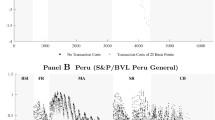Abstract
Trading rules performing well on a given data set seldom lead to promising out-of-sample results, a problem which is a consequence of the in-sample data snooping bias. Efforts to justify the selection of trading rules by assessing the out-of-sample performance will not really remedy this predicament either, because they are prone to be trapped in what is known as the out-of-sample data-snooping bias. Our approach to curb the data-snooping bias consists of constructing a framework for trading rule selection using a-priori robustness strategies, where robustness is gauged on the basis of time-series bootstrap and multi-objective criteria. This approach focuses thus on building robustness into the process of trading rule selection at an early stage, rather than on an ex-post assessment of trading rule fitness. Intra-day FX market data constitute the empirical basis of the proposed investigations. Trading rules are selected from a wide universe created by evolutionary computation tools. The authors show evidence of the benefit of this approach in terms of indirect forecasting accuracy when investing in FX markets.
Similar content being viewed by others
References
Brock W, Lakonishok J, and LeBaron B, Simple technical trading rules and the stochastic properties of stock returns, Journal of Finance, 1992, 47: 1731–1764.
White H, A reality check for data snooping, Econometrica, 2000, 68: 1097–1126.
Merton R, On the state of the efficient market hypothesis in financial economics, Macroeconomics and Finance: Essays in Honor of Franco Modigliani (ed. by Dornbusch R, Fischer S, and Bossons J), MIT Press, Cambridge, Mass., 1987.
Sullivan R, Timmermann A, and White H, Data-snooping, technical trading rule performance, and the bootstrap, The Journal of Finance, 1999, 54: 1647–1691.
Qi M and Wu Y, Technical trading-rule profitability, data snooping, and reality check: Evidence from the foreign exchange market, Journal of Money, Credit, and Banking, 2005, 38: 2135–2158.
Vinod H D and López-de-Lacalle J, Maximum entropy bootstrap for time series: The meboot R package, Journal of Statistical Software, 2009, 29(5): 1–19.
Koza J R, Genetic Programming: On the Programming of Computers by Means of Natural Selection, MIT Press, Cambridge, Mass., 1992.
Wigham P A, Grammatically-based genetic programming, Proceedings of the Workshop on Genetic Programming: From Theory to Real-World Applications (ed. by Rosca J P), Rochester, New York, 1995: 33–41.
Brabazon A and O’Neill M, Evolving technical trading rules for spot foreign-exchange markets using grammatical evolution, Computational Management Science, 2004, 1: 311–332.
O’Neill M and Ryan C, Grammatical evolution, Evolutionary Computation, 2001, 5: 349–358.
EpochX — Genetic Programming for Research: The evolutionary algorithm in EpochX. URL http://www.epochx.org/guide-algorithm.php. Accessed July 2011.
R Development Core Team, R: A Language and Environment for Statistical Computing, R Foundation for Statistical Computing, Vienna, Austria, 2011.
Author information
Authors and Affiliations
Corresponding author
Rights and permissions
About this article
Cite this article
Schmidbauer, H., Rösch, A., Sezer, T. et al. Robust trading rule selection and forecasting accuracy. J Syst Sci Complex 27, 169–180 (2014). https://doi.org/10.1007/s11424-014-3302-7
Received:
Revised:
Published:
Issue Date:
DOI: https://doi.org/10.1007/s11424-014-3302-7




